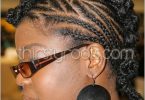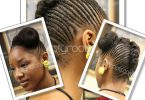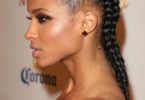If you need directions for cornrows, there are many places online that can help you. If you learn quickly just by reading, then you can simply follow the directions on the screen. Of course, there are also video demonstrations that should make it much easier too. This is actually recommended either way since it can be a little hard to understand at first.
The basic method for making cornrows is to start with a tight braid that is close to the scalp. Using an upward and underhand motion, you braid from the scalp out until you have woven an almost rope-like cord made of hair. When performed properly, it will form “rows” in the scalp, hence the name. While very time consuming and somewhat painstaking, these hairstyles are actually quite practical because you don’t necessarily have to treat them with any special chemicals or solutions and you can wash your hair like normal. It is usually a good idea to use oils or conditions to help keep your hair and scalp from getting dry or scaly, but other than that you do not necessarily have to do anything particular.
While this basic design is quite simple, cornrows have a long and colorful history of more intricate design as well. This is because their roots are very colorful. First of all, historians can trace this hairstyle as far back as 500 B.C. It has been found in historical context in Africa, Egypt, and Nigeria, from evidence discovered in hieroglyphs and sculptures. Perhaps the famous ancient sculpture of all time, the Sphinx, is the oldest and most well-known specimen to display cornrows, which are the stripes that see you on the head of the great and mysterious statue.
With such a varied history, it shouldn’t surprise you that cornrows come in many different styles. The earliest styles were actually less of a personal fashion statement and more of a way to unite tribal or community members. In ancient societies these hairstyles were commonly used to distinguish one group of people from another.
Although these hairstyles have been around for many centuries, they didn’t reach popularity in America until the 1960s when black leaders started to seek out equality. As the African-America identity truly moved to the forefront, many black Americans sought more natural, traditional hairstyles in an attempt to get in touch with their roots. The popularity of these hairstyles continued to grow, especially through the success of recent entertainers who began to wear them for similar reasons.






